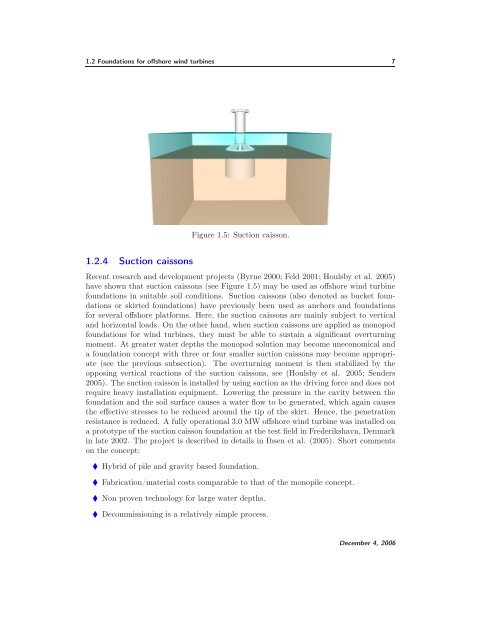Dynamic behaviour of suction caissons
Dynamic behaviour of suction caissons
Dynamic behaviour of suction caissons
You also want an ePaper? Increase the reach of your titles
YUMPU automatically turns print PDFs into web optimized ePapers that Google loves.
1.2 Foundations for <strong>of</strong>fshore wind turbines 7<br />
Figure 1.5: Suction caisson.<br />
1.2.4 Suction <strong>caissons</strong><br />
Recent research and development projects (Byrne 2000; Feld 2001; Houlsby et al. 2005)<br />
have shown that <strong>suction</strong> <strong>caissons</strong> (see Figure 1.5) may be used as <strong>of</strong>fshore wind turbine<br />
foundations in suitable soil conditions. Suction <strong>caissons</strong> (also denoted as bucket foundations<br />
or skirted foundations) have previously been used as anchors and foundations<br />
for several <strong>of</strong>fshore platforms. Here, the <strong>suction</strong> <strong>caissons</strong> are mainly subject to vertical<br />
and horizontal loads. On the other hand, when <strong>suction</strong> <strong>caissons</strong> are applied as monopod<br />
foundations for wind turbines, they must be able to sustain a significant overturning<br />
moment. At greater water depths the monopod solution may become uneconomical and<br />
a foundation concept with three or four smaller <strong>suction</strong> <strong>caissons</strong> may become appropriate<br />
(see the previous subsection). The overturning moment is then stabilized by the<br />
opposing vertical reactions <strong>of</strong> the <strong>suction</strong> <strong>caissons</strong>, see (Houlsby et al. 2005; Senders<br />
2005). The <strong>suction</strong> caisson is installed by using <strong>suction</strong> as the driving force and does not<br />
require heavy installation equipment. Lowering the pressure in the cavity between the<br />
foundation and the soil surface causes a water flow to be generated, which again causes<br />
the effective stresses to be reduced around the tip <strong>of</strong> the skirt. Hence, the penetration<br />
resistance is reduced. A fully operational 3.0 MW <strong>of</strong>fshore wind turbine was installed on<br />
a prototype <strong>of</strong> the <strong>suction</strong> caisson foundation at the test field in Frederikshavn, Denmark<br />
in late 2002. The project is described in details in Ibsen et al. (2005). Short comments<br />
on the concept:<br />
Hybrid <strong>of</strong> pile and gravity based foundation.<br />
Fabrication/material costs comparable to that <strong>of</strong> the monopile concept.<br />
Non proven technology for large water depths.<br />
Decommissioning is a relatively simple process.<br />
December 4, 2006

















